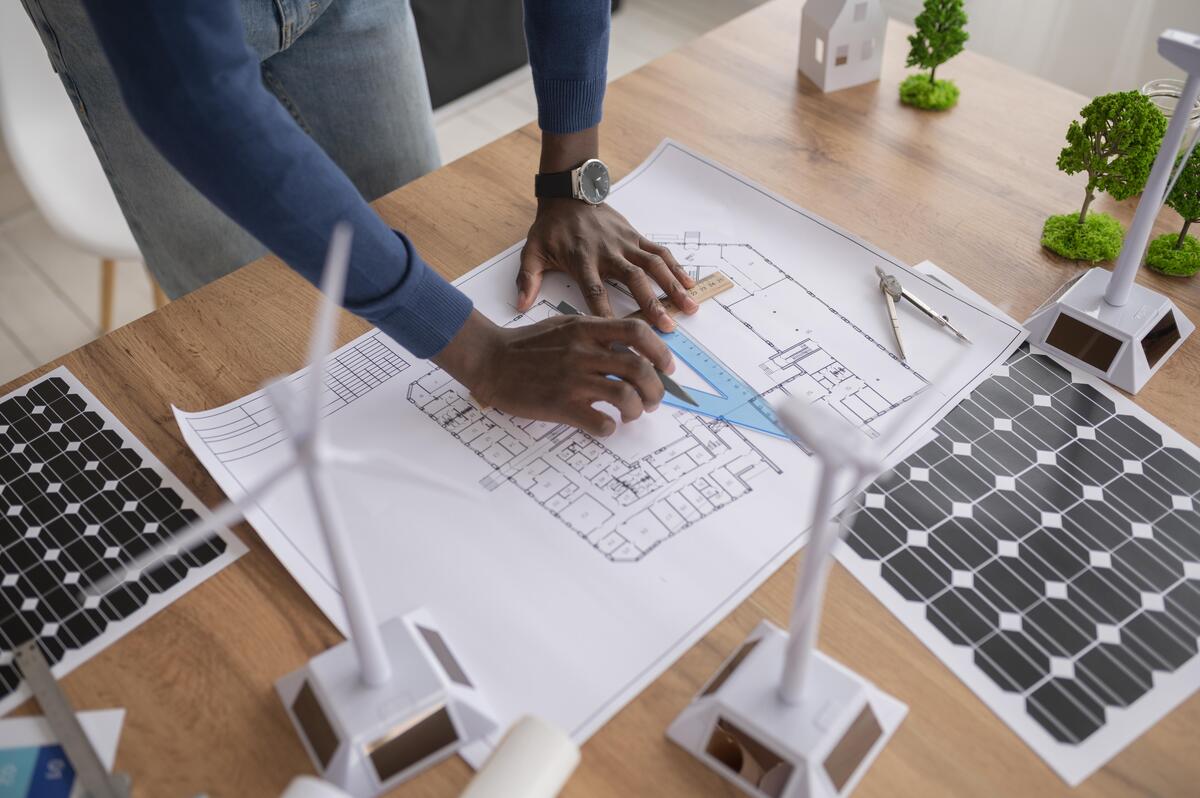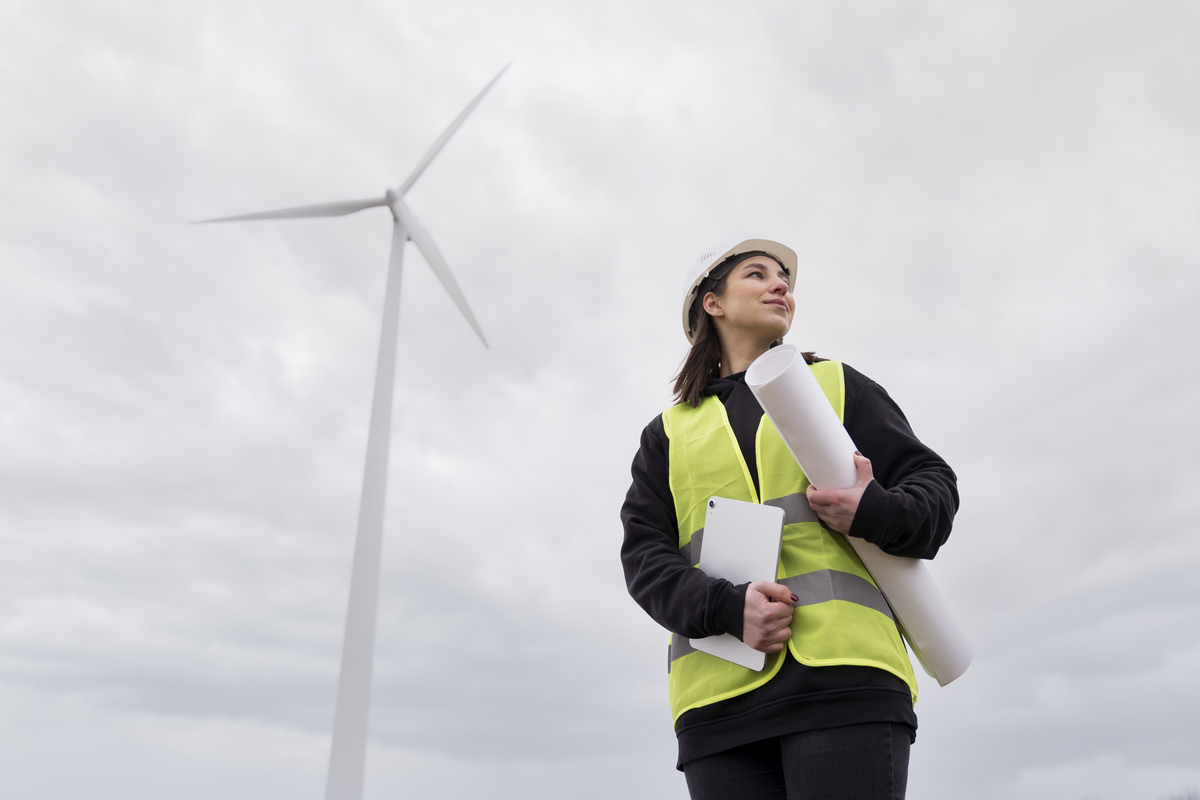Exclusive Neuroject Article: The construction industry stands as one of the largest contributors to greenhouse gas emissions, accounting for approximately 39% of carbon emissions and 33% of waste production. To address this concern, the construction sector has begun embracing sustainable practices, encompassing the use of recycled materials, renewable energy sources, and eco-conscious construction techniques. However, sustainability in construction extends beyond materials; it entails waste reduction, enhanced construction efficiency, and the extension of building lifespans.
Sustainable construction aims to reduce the environmental footprint of the industry. This involves various methods, such as using renewable and recyclable materials, minimizing the embodied energy in building materials, cutting down energy consumption in completed buildings, reducing on-site waste, and safeguarding natural habitats during and after construction.
The construction industry has a substantial impact on the environment, encompassing energy use, emissions, and habitat loss due to development. Energy-intensive construction equipment embodied energy in materials, and the ongoing energy needs of buildings all contribute to this impact. In this comprehensive guide for 2024, we embark on a journey to explore the latest innovations, strategies, and best practices that will pave the way toward a more sustainable future for construction.
Table of Contents
Introduction: What Does Sustainable Construction Entail?
Sustainable construction involves the utilization of recyclable and renewable materials in building projects while also minimizing energy consumption and waste generation. Its primary objective is to reduce the environmental footprint associated with construction.
Sustainability in construction extends beyond the project’s completion; it encompasses the design phase, focusing on long-term environmental impact. This entails integrating elements and materials that consistently reduce the structure’s environmental footprint. Examples include energy-efficient rooftop installations, solar panels, effective insulation to reduce heat loss, and decreased reliance on fossil fuel-based grid energy. Furthermore, it involves employing durable building materials with extended lifespans.
The construction industry significantly impacts the environment, contributing to 36% of global energy usage and 40% of CO2 emissions. Heavy machinery reliance on fuel, material shipping, and waste mismanagement compound these issues.
As the world increasingly emphasizes sustainability, the construction industry must align itself with this ethos. But what exactly constitutes sustainable construction, and how can we transition towards more ecologically responsible development practices?
The overarching objective is to diminish the construction sector’s environmental impact by adopting sustainable development approaches, emphasizing energy efficiency, and harnessing green technologies. The construction industry stands apart from most other sectors due to its extensive use of materials and energy, making it uniquely poised to influence the application of sustainable practices.
Why Is Sustainable Construction Vital?
The construction industry wields a substantial environmental footprint, spanning emissions, energy consumption, and resource utilization. Its carbon emissions stem from energy-intensive machinery, a heavy reliance on fossil fuels, and inefficient electricity usage.
Throughout the construction process, from raw material transportation to fabrication, carbon emissions are significantly influenced. The extraction of raw materials, such as metals, often leads to water pollution. Meanwhile, the production of concrete stands out as a major contributor to CO2 emissions. If not managed properly, construction activities can also generate hazardous waste, posing both environmental and health hazards.
The significance of sustainable construction becomes evident on multiple fronts, from curbing greenhouse gas emissions to conserving valuable resources and enhancing the long-term durability of constructed structures.
Sustainable construction entails building or renovating structures with a clear focus on reducing energy, water, and material consumption compared to conventional methods, ultimately leading to minimized waste generation. This approach plays a pivotal role in mitigating the adverse environmental impacts associated with construction projects while ensuring the long-term sustainability of our built environment.

Approaches to Enhance Construction Project Sustainability
Numerous strategies can enhance the sustainability of construction projects:
1. Renewable Energy: Incorporating renewable energy sources, such as modular battery systems charged by solar panels, can power construction equipment and reduce CO2 emissions significantly.
2. Sustainable Construction Materials:
- Wood: Sustainable forest management provides both wildlife habitat and valuable building materials.
- Alternative Bricks: Using materials like wool and mud to create bricks without kiln firing reduces harmful emissions.
- Sustainable Concrete: Employing recyclable materials and plastics as concrete substitutes minimizes carbon dioxide production.
3. Plastic Construction Materials: When used thoughtfully, plastic materials can enhance sustainability by contributing to longer-lasting buildings, reducing the need for frequent replacements and maintenance.
Embracing sustainable practices in the construction industry is imperative. Global construction companies should adopt these methods promptly to minimize adverse environmental impacts. As we progress into a more innovative and advanced world, we have the opportunity to mitigate the environmental consequences of construction projects.
Sustainable Construction Techniques
Numerous techniques facilitate more sustainable construction:
- Use of Sustainable Building Materials: Employing eco-friendly materials reduces environmental impact, saves energy, curtails pollution, and enhances indoor air quality.
- Green Construction Methods: Increasingly popular, these methods integrate sustainable materials and energy-efficient construction techniques.
- Construction Technology: Technologies like 3D printing and BIM software minimize waste, boost construction efficiency, and save energy.
- Sustainable Construction Practices: These include green roofs, solar panels, and greywater systems.
Benefits of Sustainable Construction
In the quest for a more sustainable future, the construction industry plays a pivotal role. Beyond its immediate environmental impact, sustainable construction practices offer a multitude of benefits. These eco-conscious methods extend their advantages to various facets of the industry, revolutionizing how we build and live in structures. Let’s delve into the transformative world of sustainable construction and explore how it is shaping the way we design, construct, and inhabit our built environment.
- Promotion of Healthier Living: Green buildings enhance occupant well-being. For instance, in green office buildings, cognitive function scores improved by 61%, and decision-making effectiveness increased by 44%. Green hospitals saw a 56% increase in satisfaction levels and a reduction in Seasonal Affective Disorder.
- Reduction of Waste: Sustainable construction inherently reduces waste by using fewer resources, relying on recycled and renewable materials, and adopting eco-friendly construction techniques. This approach also enhances human health by reducing exposure to harmful substances.
- Economic Boost: Sustainable construction creates job opportunities and stimulates economic growth. As the world addresses climate change, demand for construction workers has surged, leading to more construction-related jobs.
- Promotion of Sustainability: Sustainable construction advocates for responsible energy and resource use. It raises awareness about the importance and efficiency of sustainable practices while sending a clear message to the construction industry and society that sustainability is essential.
Adopting sustainable construction practices reduces an organization’s environmental impact and lowers operational costs. Sustainable designs improve reputations and corporate social responsibility. Contractors can access innovative projects by understanding new materials and techniques. Green buildings offer lower operating costs and potential annual global energy savings of €410 billion through sustainable technologies.
Sustainability also leads to direct savings, such as reduced waste management fees and fuel costs. Demonstrating corporate social responsibility through sustainable construction practices can enhance an organization’s reputation and influence buyer behavior.
Challenges of Sustainable Construction
Numerous obstacles impede the widespread acceptance of sustainable construction practices, including upfront expenses, limited awareness, and resistance to change. Building code requirements and a lack of experience also present hurdles. Challenges encompass cost concerns, awareness gaps, and resistance to shifting mindsets. Client perspectives and financial constraints can hinder sustainability endeavors; nevertheless, green buildings present opportunities for enhanced financial prospects.
Transitioning to Sustainable Construction
The transition to sustainable construction is a gradual process influenced by client attitudes and budgets. Architects play a pivotal role in driving sustainable practices, with organizations like the Royal Institute of British Architects (RIBA) emphasizing aspects such as net-zero operational carbon and sustainable water usage. Affordability remains a concern, as 40% of UK firms cite it as a major challenge, with almost half anticipating higher initial costs for green buildings. Balancing client demand for sustainability with budget considerations remains an ongoing challenge for construction firms.
Challenges of Sustainable Construction Adoption
While the benefits of sustainable construction are undeniable, the shift towards more sustainable methods necessitates time, preparation, and the adoption of best practices. Training is essential, requiring both time and financial investment. An enduring challenge is the perception of higher initial costs associated with sustainable construction, often viewed as having a premium compared to conventional methods.
The Significance of Sustainable Construction
Despite potential obstacles, the importance of sustainable construction cannot be overstated. The global impacts of climate change are already apparent, compelling public and private sector stakeholders to embrace greener construction practices. Sustainability is essential for enhanced quality of life and environmental well-being, ensuring clean air, resource preservation, and a non-toxic environment. Technological advancements and sustainable material usage allow the construction industry to lead in promoting greener projects.
Sustainable Construction’s Continuing Evolution
Sustainable construction is evolving in response to heightened demand for cleaner, eco-friendly spaces, accentuated by the growing impacts of climate change. Although challenges persist, the advantages linked to sustainable construction illuminate the path towards a more environmentally friendly future.
Renting Equipment for Environmentally Conscious Construction
Contributions to eco-friendly practices are not limited to large construction companies; individuals undertaking private projects can also prioritize sustainable construction methods. Choosing the right equipment, identifying sustainable material alternatives through value engineering, and striving for energy efficiency are accessible to everyone. Regardless of your project’s size, having access to the right tools is crucial.
BigRentz offers equipment rentals across the United States, streamlining machinery rental for green building projects and other construction tasks, ensuring successful project completion.

Sustainable Construction Practices
In the quest for a more sustainable future, the construction industry plays a pivotal role. Beyond its immediate environmental impact, sustainable construction practices offer a multitude of benefits. These eco-conscious methods extend their advantages to various facets of the industry, revolutionizing how we build and live in structures. Let’s delve into the transformative world of sustainable construction and explore how it is shaping the way we design, construct, and inhabit our built environment. Practices include:
Materials and Resources
Sustainable construction is founded on the careful selection of materials and resources. This encompasses the use of eco-friendly materials such as wool and clay bricks, which have lower environmental footprints compared to traditional counterparts. Embracing recycled plastics and responsibly sourced wood is another hallmark of sustainable practices, ensuring that valuable resources are conserved and reused. Additionally, innovative techniques like utilizing straw bales for insulation not only enhance energy efficiency but also minimize the reliance on energy-intensive materials, promoting a more sustainable approach to insulation.
Energy Efficiency
Energy efficiency lies at the core of sustainable construction. It involves a two-fold approach: harnessing renewable energy sources and implementing energy-efficient building designs. Integrating solar panels, wind turbines, and other renewable energy technologies not only reduces the reliance on fossil fuels but also contributes to a cleaner and more sustainable energy grid. Furthermore, energy-efficient building design encompasses strategies like optimizing building orientation, improving insulation, and employing high-efficiency HVAC systems, all of which lead to reduced energy consumption and lower carbon emissions.
Water Efficiency
Sustainable construction places a strong emphasis on water conservation. This is achieved through innovative methods such as rainwater harvesting and greywater recycling, which reduce the demand for traditional water sources. Additionally, the incorporation of low-flow fixtures, like faucets and toilets, helps minimize water wastage within buildings. These water-efficient practices not only contribute to environmental conservation but also lead to significant cost savings in the long run.
Indoor and Environmental Quality
Sustainable construction goes beyond the exterior of buildings; it prioritizes creating safe and healthy indoor environments. This involves using non-toxic, low-VOC (volatile organic compound) materials and paints to ensure that indoor air quality remains pristine. Adequate ventilation and natural lighting are also key considerations, enhancing the comfort and well-being of building occupants. Sustainable construction strives to create spaces where people can thrive and be productive while minimizing the impact on the natural environment.
Site Selection and Planning
Before construction even begins, sustainable practices come into play during the site selection and planning phases. Optimal location choices take into account factors like proximity to public transportation, minimizing the need for personal vehicles, and reducing emissions. Thoughtful design integration considers the local ecosystem, ensuring minimal disruption to natural habitats and a harmonious coexistence between the built environment and the surrounding ecology. These considerations not only contribute to sustainability but also foster a sense of responsibility towards the land and the communities it serves.
Incorporating these sustainable construction practices into the building industry represents a significant stride towards a more environmentally responsible and socially conscious future. As we continue to innovate and evolve, the construction sector stands poised to lead the way in reshaping our world for the better.
Case Studies in Sustainable Construction
Sustainable construction principles come to life through real-world examples that showcase innovation, environmental consciousness, and a commitment to a greener future:
1. Terra Bio Hotel: This remarkable project stands as a testament to sustainable construction practices. By utilizing reused materials, adopting soil-based construction techniques, and incorporating energy-efficient design, Terra Bio Hotel reduces its environmental impact while providing guests with a unique and eco-conscious experience. Rainwater capture and waste management further exemplify the holistic approach to sustainability embraced by this establishment.
2. The Bullitt Center in Seattle: A beacon of sustainability in the heart of Seattle, The Bullitt Center is a net-zero-energy and net-zero-water building. It not only incorporates sustainable features but also champions locally sourced materials, reducing transportation-related emissions. Designed with occupant comfort in mind, this structure demonstrates that sustainable buildings can prioritize both environmental responsibility and human well-being.
3. Sustainable Construction Adoption in the UAE: The United Arab Emirates (UAE) has emerged as a trailblazer in the adoption of sustainable construction practices, underpinned by a robust commitment to environmental sustainability. Initiatives like “The Year of Sustainability,” the development of smart sustainable cities, and the UAE government’s National Guide for Smart Construction exemplify the country’s dedication to sustainability. Iconic projects like Masdar City, the Sustainable City in Dubai, the BEEAH Headquarters, and the Dubai World Expo 2020 demonstrate the UAE’s leadership in sustainable infrastructure development. These endeavors not only showcase the nation’s commitment to reducing its environmental footprint but also serve as inspirational models for sustainable construction on a global scale.

Sustainable Building Materials
One of the most effective means of fostering sustainability in construction lies in the choice of materials. A new generation of robust, lightweight, and groundbreaking building materials is emerging, capable of addressing various industry challenges and promoting more sustainable methodologies.
These materials offer an added advantage by reducing the carbon footprint of buildings constructed with them, contributing to a cleaner planet and a future marked by sustainability. Moreover, they possess aesthetic appeal and enhanced efficiency.
Noteworthy Sustainable Building Materials
Here’s the list of sustainable building materials alongside their benefits:
1. Bamboo
With its renewable and versatile attributes, bamboo ranks among the most sustainable construction materials. Despite being a type of grass, bamboo boasts wood-like strength while retaining flexibility. It finds applications in supporting concrete, scaffolding, roofing, and other structural elements.
Benefits:
- Rapidly renewable material
- Cost-effective and environmentally friendly in terms of cultivation and harvesting
- Absorbs more CO2 than trees, potentially leading to improved air quality in surrounding environments.
2. Recycled Plastic
In 2021, the global population generated 139 million tons of single-use plastic, much of which ended up in landfills or polluting waterways. Advancements in construction and technology now enable the recycling of plastic to produce building materials such as plastic sheets, bricks, and lumber.
Benefits:
- Mitigates waste accumulation in landfills and pollution in waterways
- Recycled plastic obviates the need for the toxic preservative sealants required for lumber.
3. Laminated Timber
Also referred to as mass timber, laminated timber represents prefabricated timber with superior strength and water resistance compared to traditional timber. Its potential to replace steel and concrete is notable, given that the production of steel and concrete results in considerably higher carbon footprints.
Applications of laminated timber encompass structural elements like beams and columns, as well as roofing and flooring.
Benefits:
- Smaller carbon footprint during production relative to steel and other structural materials
- Enhanced speed of construction, reducing associated CO2 emissions.
4. Stone
Stone is a naturally occurring material found in the earth and serves both as a building material and in household items such as tiles and countertops. It combines durability with low maintenance requirements and generates minimal to no waste when employed in construction projects.
Given its natural origin, stone often necessitates no factory production, further curbing CO2 emissions.
Benefits:
- Long-lasting investment that requires little to no replacement
- Recyclability for use in other projects or for roadbed construction, minimizing waste.
These sustainable building materials exemplify the construction industry’s potential to adopt more environmentally friendly practices while simultaneously addressing its unique challenges.
5. Cob
Cob represents a mixture of mud composed of natural elements like soil, straw, sand, and lime. Cob is frequently employed in the construction of residential buildings or as a substitute for concrete structures.
The production of cob is cost-effective and generates less CO2 when compared to concrete production. However, it comes with certain drawbacks, such as a longer construction time and increased vulnerability to mold in humid conditions.
Benefits:
- An all-natural and budget-friendly alternative to concrete for smaller structures.
- Prevents heat transfer, reducing heating and energy expenses while minimizing the home’s carbon footprint.
6. Cork
Cork is presently a common choice in European construction and is gradually gaining popularity in the United States for insulating homes and other structures. Cork is sourced from cork oak trees, with the material harvested by hand from the tree’s bark, and importantly, this process does not harm the tree.
As a renewable and recyclable resource, cork serves as an eco-friendly replacement for conventional insulation materials that require manufacturing.
Benefits:
- Cork is a renewable resource that is harvested without harming the environment.
- Production yields a smaller carbon footprint compared to traditional human-made insulation materials.
- Possesses mold-resistant properties.

7. Adobe Brick
The use of adobe bricks has ancient origins and remains prevalent in the Middle East and the Americas. Adobe is a blend of clay and straw utilized to create bricks for constructing homes and various structures. The primary appeal of adobe lies in its utilization of naturally occurring materials from the earth, requiring less energy for production.
Benefits:
- Contains inherent insulating properties, maintaining consistent indoor temperatures, leading to reduced energy bills and a smaller carbon footprint.
- Adobe is recyclable multiple times, leaving no waste behind.
- Comprises sustainable materials from the earth.
8. Reclaimed Wood
Wood, due to its ease of use and natural beauty, ranks as the most popular building material. Unfortunately, it often goes to waste during demolition projects. Reclaimed wood technology now allows for the deconstruction of lumber from older structures while preserving its integrity. Contractors and carpenters can utilize reclaimed wood in new construction projects or for home furnishings and decor.
Benefits:
- Reduces the necessity to cut down and harvest trees for new wood.
- An effective measure in curbing deforestation.
9. Precast Concrete
Although concrete often contributes to CO2 emissions at construction sites, it remains an essential material. This is where precast concrete comes into play. Precast concrete is manufactured in precise measurements at a factory and then transported to the construction site.
While the distinction between regular and precast concrete may not be readily apparent, precast concrete can be observed in structures such as bridges, foundations, parking garages, and occasionally entire buildings.
Benefits:
- Precise batch technology in production reduces waste.
- Adaptable to various climates without cracking or sustaining other damages.
10. Mycelium
Mycelium refers to the slender fibers of fungi that run beneath the ground like roots. When harvested and dried, mycelium transforms into an extremely durable, water-resistant, mold-resistant, and fire-resistant building material.
Dried mycelium can be blended with other materials, such as sawdust and demolition waste, to create bricks for constructing buildings. Although not widely used at present, mycelium represents an organic and renewable resource with the potential to revolutionize the construction industry.
Benefits:
- A renewable and environmentally friendly resource.
- Completely compostable, leaving no waste behind.
11. Sheep’s Wool
Sheep’s wool is a renewable and natural resource that can be harvested and used without harming the animal. While wool is typically associated with clothing and textiles, it also serves as an effective insulation material for buildings. Unlike synthetic insulation, sheep’s wool is natural, non-toxic, and resistant to mold.
Benefits:
- Longer lifespan, resulting in less waste over time.
- More effective than its synthetic counterparts.
- Offers greater energy savings to users.
12. Pollution-Absorbing Brick
In response to mounting environmental concerns, air pollution remains a significant challenge that is difficult to address. While other sustainable building materials effectively reduce CO2 emissions, pollution-absorbing bricks aim to neutralize emissions.
These double-layered bricks feature porous blocks that allow air to pass through while filtering out coarse and fine pollutant particles. While pollution-absorbing bricks are not yet common in construction, this futuristic material represents a sustainable, air-purifying alternative to traditional earth bricks.
Benefits:
- Self-sustaining ventilation system.
- An innovative solution for greener construction materials and practices.
- Growing cities can utilize this technology to provide cleaner air for their residents.
13. 3D-Printed Concrete
We are aware that concrete is a building material with enduring significance. While there are a few viable alternatives to concrete, there are also methods to enhance the sustainability of concrete production. One such method is the application of 3D printing. The use of 3D-printed concrete enables contractors to digitally design any shape and employ concrete for precise fabrication.
Benefits:
- Time, energy, and cost-efficient.
- On-demand printing minimizes waste.
- Reduces energy and transportation costs associated with material delivery.
14. Cordwood
Cordwood construction employs stacked short logs, resembling firewood, to construct walls. Cob or mortar is used to bond the wooden logs together. Cordwood construction is typically found in homes, lending a rustic cottage aesthetic to the overall structure. Cordwood offers natural insulation and utilizes local materials to reduce energy and transportation expenses.
Benefits:
- Economical and straightforward to construct.
- Saves time and energy during home construction.
- The combination of cob and wood minimizes heat transfer, reducing energy consumption.

15. Recycled Tires
Until recently, rubber tires were not recycled and contributed to landfill clutter. Fortunately, experts have identified that the rubber found in tires possesses durability, flexibility, and insulating properties, all of which are valuable attributes in building materials.
Some sustainability-oriented homes, known as Earthship homes, utilize recycled tires filled with sandbags for insulation. Others are researching methods to create rubber masonry blocks from recycled tires for use in new structures.
Benefits:
- A sustainable approach to diverting tires from landfills.
- A recycled material is suitable for home insulation.
16. Newspaper Wood
Despite paper being one of the easiest materials to recycle, the issue of paper waste is growing. With innovations and technological advances, companies like Newspaper Wood aim to transform paper back into wood. While newspaper wood is not yet usable in construction projects, promising results have been achieved in the realm of furniture and home decor.
Benefits:
- Diverts paper waste away from landfills.
- Mitigates the overconsumption of fresh lumber.
- Contributes to the reduction of deforestation.
17. Plant-Based Polyurethane Rigid Foam
Rigid foam, known for its effectiveness as insulation in homes and commercial buildings, has been in use for decades. However, the original version of rigid foam contained a compound that was detrimental to the environment. This is where the newer, eco-friendly variant of rigid foam comes into play.
Plant-based polyurethane rigid foam incorporates a blend of bamboo, hemp, and kelp, making it an excellent choice for wall insulation. This improved rigid foam also finds utility in furniture and even surfboards.
Benefits:
- Offers protection against mold and pests.
- Boasts a longer lifespan compared to traditional insulation methods.
- Provides high-quality thermal insulation, resulting in energy and cost savings for heating and cooling.
18. Straw Bales
The use of straw in construction has historical roots, and it remains one of the most readily available sustainable building materials today. Similar to many of the previously mentioned materials, straw is a renewable resource that serves effectively as insulation.
When adequately shielded from moisture, straw bale insulation can endure for extended periods.
Benefits:
- Enhances indoor air quality and absorbs carbon dioxide.
- Generates low emissions, particularly when compared to synthetic insulation.
- A rapidly renewable and entirely natural reusable insulation material.
- Biodegradable, leaving no waste in its wake.
19. Recycled Glass
Glass is among the most challenging materials to recycle, leading to its disposal in landfills and environmentally compromised locations. In a progressive step forward, recent studies have revealed that construction projects can employ waste glass to replicate natural aggregates, such as sand, gravel, and crushed stone.
Cement manufacturers can also incorporate recycled glass into their mixtures. Although the use of recycled glass is not yet commonplace in construction, this emerging development holds promise for the environment and landfill management.
Benefits:
- Diverts discarded glass from landfills, waterways, and polluted areas.
- Provides an alternative to natural resources in construction.
20. Recycled Steel
As previously noted, steel production can be environmentally detrimental, despite its ongoing necessity for structural frameworks and support systems. A standout feature of steel is its limitless life cycle, enabling it to be recycled repeatedly without compromising quality or durability.
The incorporation of recycled steel in new construction projects conserves energy while substantially reducing the project’s carbon footprint.
Benefits:
- Slows the production of new steel, which emits significant CO2.
- Steel is the most easily recyclable material without degradation in quality or value.
Sustainable Construction Practices Sustainable construction encompasses more than just the materials used by contractors in their projects. Certain construction practices and techniques have been proven to be environmentally friendly and contribute to sustainability efforts. Sustainable construction practices include, but are not limited to:
- Precise measurements to reduce material wastage during cutting and production.
- Enhanced waste management through recycling materials.
- Construction of green buildings designed for environmental efficiency.
- Renovating existing structures instead of constructing new ones.
- Managing and minimizing CO2 emissions generated by construction sites.
- Encouraging eco-friendly practices among on-site workers, such as recycling food packaging, using reusable containers, refraining from smoking, and reducing paper usage.
- Conserving energy and utilizing sustainable materials as mentioned above.

Conclusion: The Sustainable Outlook
With growing sustainability expectations set by regulators and building codes, the bar is rising for everyone in the construction sector. The environmental impact of every industry is under scrutiny, prompting more construction projects to incorporate sustainable approaches to meet client demands. To achieve sustainability goals and effectively manage change, organizations can utilize ISO 14001 as a framework within the sustainable construction supply chain.
The construction industry’s substantial consumption of natural resources has made it imperative to reduce its environmental impact due to climate change. Governments are increasingly emphasizing sustainability in construction.
With climate change and resource depletion threatening our world, sustainable construction is now a necessity. It involves renewable materials, reduced energy usage, minimized waste, innovative design, and benefits in environmental, social, and economic aspects. Every construction business must contribute to a sustainable future.
While the construction industry is gradually embracing sustainable practices, there is room for further progress. Increasing awareness of the benefits of sustainable construction and providing support and information to industry professionals are essential steps toward accelerating this transition to a sustainable future.
Resources:
Construction21 | Proest | Plan Radar | British Assessment | Big Rentz | Forbes | BuildPass | bsiKnowledge | Holcim Foundation
For all the pictures: Freepik | Unsplash



